hankyoreh
Links to other country sites 다른 나라 사이트 링크
[Reportage] Recovering troops’ remains and belongings on Arrowhead Hill

There were clear bullet holes in the twisted metal canteen. There was still an unfired round in the gun’s chamber. The rusted helmet was pocked with holes where bullets had passed through. These are some of the traces of war that have been discovered as part of a project to recover remains at Arrowhead Hill (Hwasalmeori), in Cheorwon County, Gangwon Province.
Relics of the war that had been buried for nearly 70 years have been unearthed at last. On May 28, I took a trip to Arrowhead Hill, the location of four battles between November 1951 and July 1953, when the South Korean and UN forces fought against the North Korean and Chinese forces. While the hill repeatedly captured and recaptured, more than 300 South Korean and UN soldiers and more than 3,000 North Korean and Chinese soldiers died or went missing here.
For nearly two months now, since Apr. 1, the South Korean military has been clearing mines and doing other preparatory work for a joint recovery effort with North Korea. Arrowhead Hill is located close to the non-permanent guard post in Cheorwon County that is the final stop on the Cheorwon section of the DMZ Peace Trail, which will be opened up to the general public in June. From the top of the guard post, the recovery site at Arrowhead Hill can be seen immediately to the north.
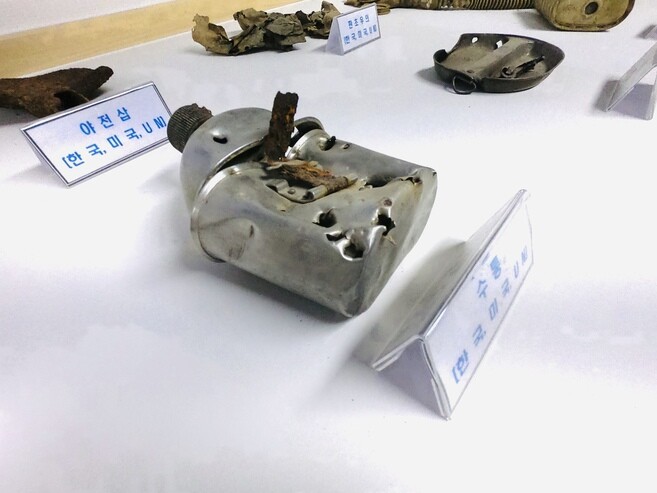
The red slopes of Arrowhead Hill jut out from the green of the luxuriant leaves and grass surrounding it. The hill used to be covered with grass, too, but that was cleared away to aid the recovery efforts. It had rained the day before, and the ground gave off the heavy scent of dirt and the astringent smell of the grass.
Soldiers assigned to the recovery dug into the dirt with their hoes, while the air compressor hummed nearby. As the soldiers moved the air compressor around the site, it sent dirt whirling through the air. By 10 that morning, the recovery effort here had already been underway for two hours. Soldiers were looking for remains and removing mines at various places along the steep ridge, which slopes down at an angle of 45 degrees.
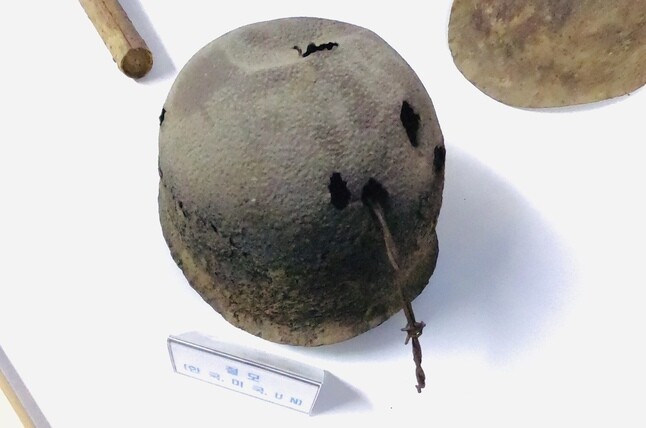
Several pits could be seen, with a depth of 2m. A soldier explained that these were dugouts. A communication trench had been dug during the Korean War to enable soldiers to move safely even when they were under attack, and dugouts were found on the slope of the hill immediately below the trench. Also called “cave bases,” the dugouts were large enough for about eight people to take shelter. At this early stage in the recovery effort, the communication trenches run for about 300m altogether, and 12 cave bases have been found so far. Workers have also uncovered around 30 smaller foxholes just big enough to conceal a single soldier.
As of May 28, workers have turned up 325 human remains, which are presumed to belong to the bodies of 50 soldiers who died during the Korean War. During less than two months, 23,055 personal effects have been found — including firearms, body armor, helmets, canteens, and rank badges — along with 138 mines and 2,180 rounds of unexploded ordnance. And that’s just during the initial phase: once the project begins in earnest, even more remains and items are expected to turn up. This recovery project is of particular significance since it’s the first to occur inside the demilitarized zone (DMZ).
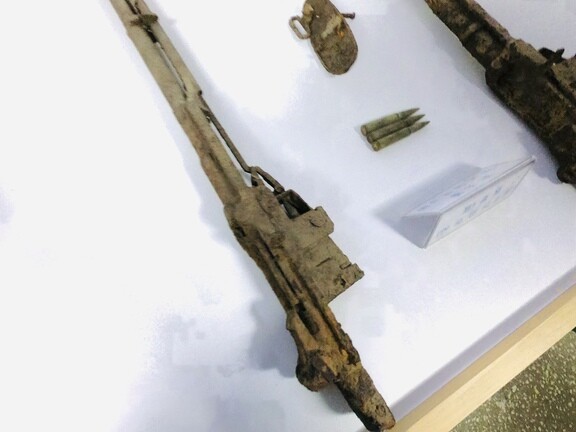
DMZ remains left untouched for almost 70 years
Since 2000, military authorities have been exhuming the remains of soldiers killed in the areas that saw intense combat during the Korean War. But no digging had taken place in the DMZ before the military agreement on Sept. 19 of last year. With no development in the area – or any human activities at all, for that matter – for nearly 70 years, the remains and personal effects that have been uncovered are reportedly less damaged or compromised than at other exhumation sites. Since Apr. 4, the complete remains are what are believed to be four people were uncovered all at once in the same location.
“It’s surprising to see the different items that have not been found at South Korean exhumation sites outside the DMZ, as well as the perfectly preserved state of the personal effects and remains from the Korean War,” said Kang Jae-min, who heads the exhumation team for the Ministry of National Defense’s human remains exhumation and identification group.
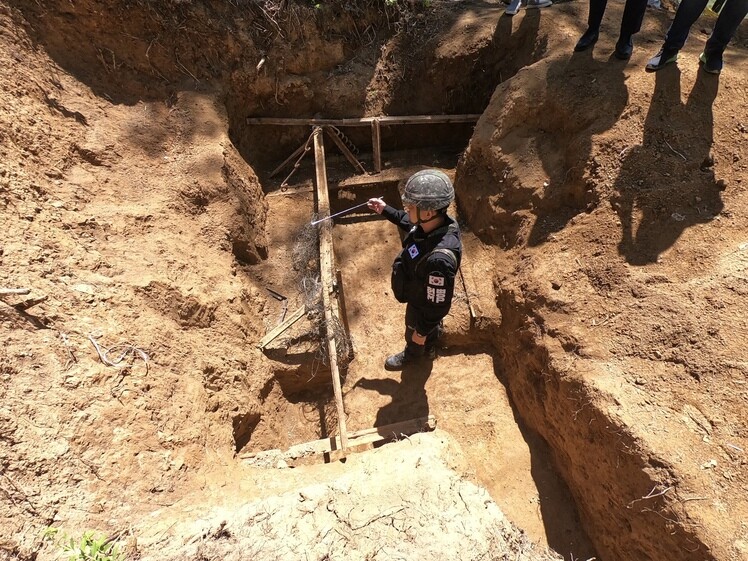
A large number of personal items have been discovered. Over 100 rounds of ammunition and empty cartridges were found in a recently located dugout measuring 3m on each side and 2m deep. Also found there was a pile of items including combat boots, bulletproof vests, flashlights, bullets, toiletry bottles, canteens, cups, pistol magazines, gun oil canisters, snap buttons, and toothbrushes. A helmet was discovered with crushed fragments of skull inside. The items suggest the dugout was used by South Korean troops, while the skull fragments in the helmet appeared to belong to a South Korean soldier, military authorities said.
“Inside the dugout, we’ve found what appears to be rebar and field wires used for communications and telephone lines that have been woven together into the shape of a chair,” Kang said.
“Based on the items that have been found here, we think it may have been a place either for operations or for resting. It could also be that troops hid in places like caves with the enemy forces advancing in waves and called for artillery file to wipe out the other side,” he added.
Looking at the North Korean side from the top of the Arrowhead Hill ridge, one can see the pathway created by the North last year for mine clearing efforts ahead of the joint exhumation. The path links South and North across the Military Demarcation Line (MDL), but has yet to see any travel. The distance from Arrowhead Hill to the MDL is just 500m. Just next to the hill are Peacock Ridge and White Horse Hill, which was the site of another intense battle. Water flows in between the two hills; it meanders up and down, heedless of the MDL, and has been dubbed “Yeokgok Stream.” Literally meaning “curving backward,” the name refers to the way it winds from north to south and then back again from south to north.

No North Korean soldiers showed up to observe exhumation
Since Apr. 1, South Korean military authorities have undertaken groundwork for the exhumation work as promise to honor the Sept. 19 military agreement. South and North were initially supposed to do the exhumation together, but North Korea showed no signal of its intention to begin the joint exhumation by the appointed day. South Korean military authorities have gone ahead on their own with the digging to start. The current groundwork activities include clearing mines for a future joint exhumation. Basic exhumation activities are also under way in areas where large numbers of remains have been uncovered during the mine clearing. As of May 28, basic digging had taken place over an area of 12,650㎡ with mine clearing over an area of 149,000㎡, for a total of 161,650㎡ involved in the exhumation.
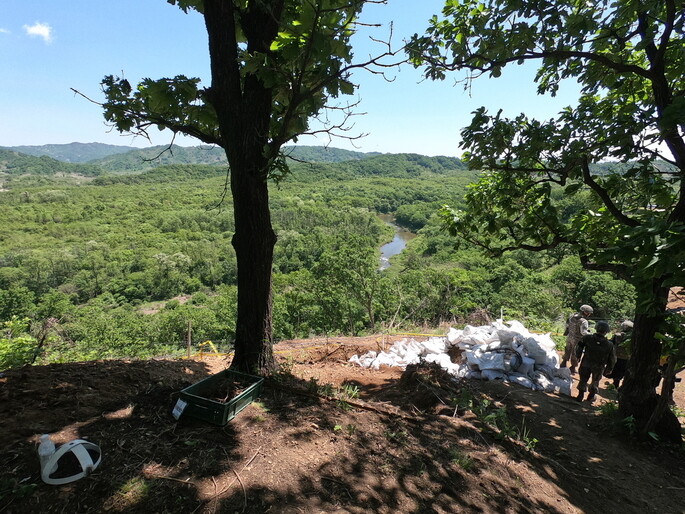
Military sources also reported that the North Korean military appeared to be closely observing the South’s exhumation efforts from their guard post on the northern side. While North Korean soldiers came out last year to individually check on all actions by the South Korean side, no such activities have been observed at all this year, sources on the ground said.
By Noh Ji-won, staff reporter
Please direct comments or questions to [english@hani.co.kr]

Editorial・opinion
![[Column] Park Geun-hye déjà vu in Yoon Suk-yeol [Column] Park Geun-hye déjà vu in Yoon Suk-yeol](https://flexible.img.hani.co.kr/flexible/normal/500/300/imgdb/original/2024/0424/651713945113788.jpg) [Column] Park Geun-hye déjà vu in Yoon Suk-yeol
[Column] Park Geun-hye déjà vu in Yoon Suk-yeol![[Editorial] New weight of N. Korea’s nuclear threats makes dialogue all the more urgent [Editorial] New weight of N. Korea’s nuclear threats makes dialogue all the more urgent](https://flexible.img.hani.co.kr/flexible/normal/500/300/imgdb/original/2024/0424/7317139454662664.jpg) [Editorial] New weight of N. Korea’s nuclear threats makes dialogue all the more urgent
[Editorial] New weight of N. Korea’s nuclear threats makes dialogue all the more urgent- [Guest essay] The real reason Korea’s new right wants to dub Rhee a founding father
- [Column] ‘Choson’: Is it time we start referring to N. Korea in its own terms?
- [Editorial] Japan’s rewriting of history with Korea has gone too far
- [Column] The president’s questionable capacity for dialogue
- [Column] Are chaebol firms just pizza pies for families to divvy up as they please?
- [Column] Has Korea, too, crossed the Rubicon on China?
- [Correspondent’s column] In Japan’s alliance with US, echoes of its past alliances with UK
- [Editorial] Does Yoon think the Korean public is wrong?
Most viewed articles
- 1‘We must say no’: Seoul defense chief on Korean, USFK involvement in hypothetical Taiwan crisis
- 2N. Korean delegation’s trip to Iran shows how Pyongyang is leveraging ties with Moscow
- 346% of cases of violence against women in Korea perpetrated by intimate partner, study finds
- 4[Column] Park Geun-hye déjà vu in Yoon Suk-yeol
- 5‘Weddingflation’ breaks the bank for Korean couples-to-be
- 6Will NewJeans end up collateral damage in internal feud at K-pop juggernaut Hybe?
- 7Amnesty notes ‘erosion’ of freedom of expression in Korea in annual human rights report
- 8[Interview] Dear Korean men, It’s OK to admit you’re not always strong
- 9Korean government’s compromise plan for medical reform swiftly rejected by doctors
- 10[Editorial] Japan’s rewriting of history with Korea has gone too far